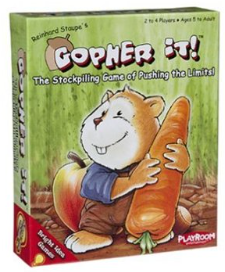 |
Gopher It! Help the gopher store up food for the winter. |
A card game of collecting sets of gopher food and counting. This game consists of two sets of heavyweight cards: gopher food cards (carrots, nuts, and apples) and gopher trophy cards.
Object:
Be
the first person to collect exactly six points for a single food to
win a gopher trophy card. Play several games and see who can collect the
most gopher trophy cards.
Set up:
Mix and scatter, face-down, all the food cards in the middle of the players.
Play:
Players take turns flipping cards in an attempt to collect six points of any one food. A player can turn over anywhere between one and four cards per turn. Each player chooses how many to turn over each turn. Players may keep all the cards they flip unless they turn over two of the same food in a row. If that happens, player loses all the cards that have been turned over on that turn. Therefore, to avoid losing cards, a player may decide to stop before turning over four cards. If cards are won, the player separates them by food in front of him and his turn is over. Once a player has collected a total of six points for any single food, the game is over and he wins. Or, player several rounds to see who collects the most trophy cards.
Try this:
- Play as a simple matching game. Turn cards face-down and then flip over two at a time. try to match either food only, number only, or number and food.
- Add a couple of the trophy cards to the original game. If, while you are turning cards face-up, you turn over a trophy, you turn ends immediately.
- Work
on visual discrimination, visual memory, matching, simple strategy,
manual dexterity, simple counting, socialization skills, process skills, play and leisure
exploration and participation
In the box: 50 cards
Ages 5+, 2-4 players
If you are interested in purchasing this game or just want more information, click on the image below.











